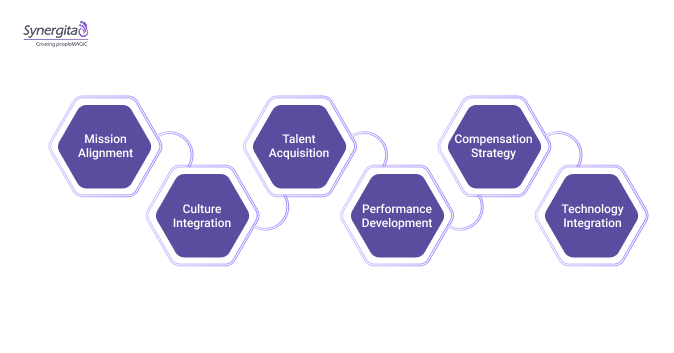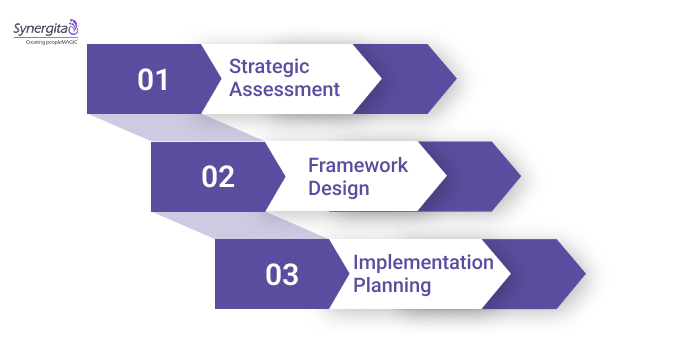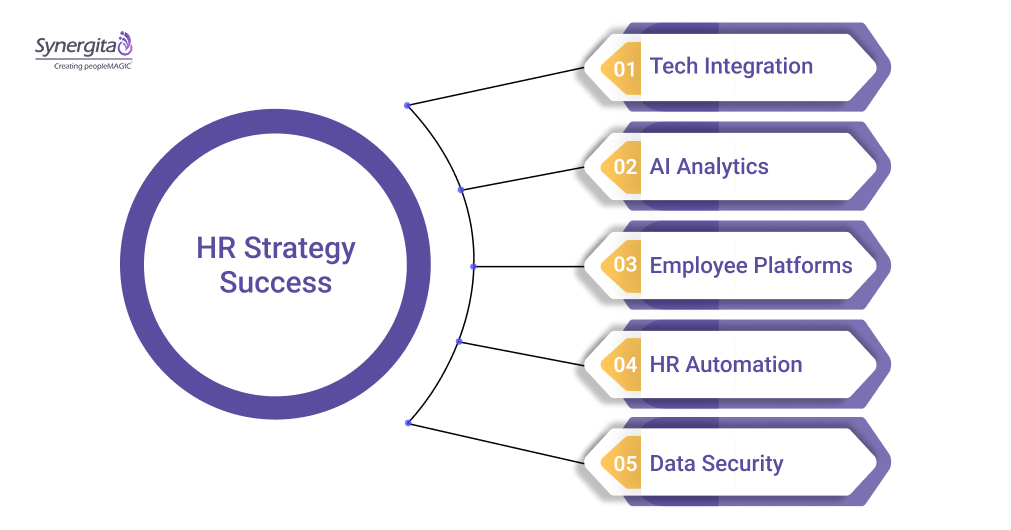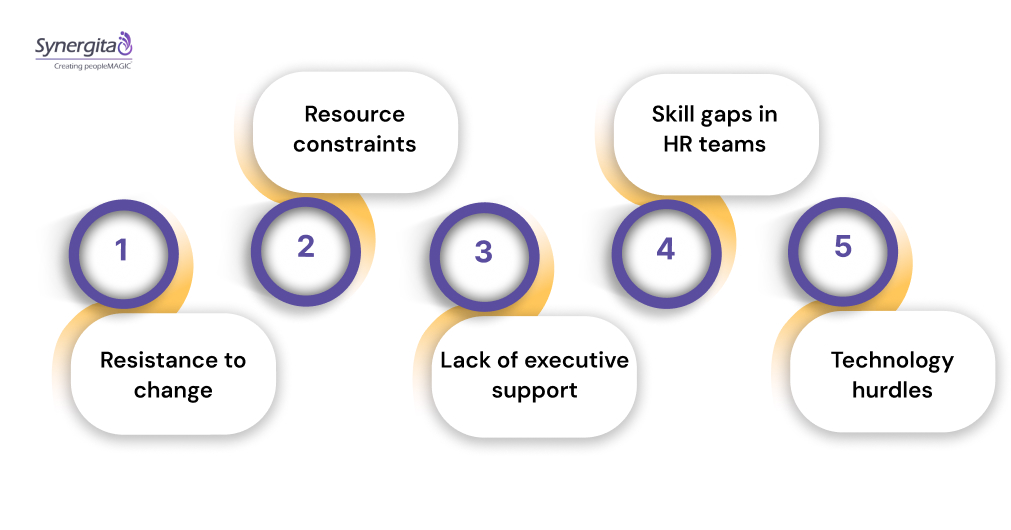An HR strategy framework is a structured roadmap that aligns your people practices with the company’s long-term objectives.
Unlike ad hoc HR functions, a framework brings clarity, consistency, and purpose to how talent is managed. It ensures that every hiring decision, performance conversation, and engagement initiative contributes directly to organizational growth.
When done right, a framework builds resilience, strengthens culture, and improves agility in responding to market shifts. Organizations that design their HR around strategy instead of routine administration experience stronger retention, higher productivity, and measurable business impact.
In this article, we’ll explore what an HR strategy framework is, its components, proven models, and how you can build one tailored to your organization’s needs.
Key Takeaways
- Link HR and Business Goals: Think of your HR strategy framework as the bridge that connects your people practices directly to what your business needs most.
- Focus on the Core Building Blocks: Culture, hiring, performance, pay, and technology are the main pillars that keep your HR strategy steady and strong.
- Lean on Trusted Frameworks: Models from Deloitte, McKinsey, and Harvard are like trusted maps—use them to guide your HR strategy without starting from scratch.
- Take It Step-by-Step: Don’t rush—build your HR plan by first understanding needs, crafting a design, managing change, and rolling it out in manageable stages.
- Keep Measuring and Evolving: Your strategy should breathe and grow. Track key results constantly and tweak as your company and market change.
What Is an HR Strategy Framework and Why It Matters
At its core, a framework provides a structured approach to managing the employee lifecycle, from recruitment and development to retention and succession planning.
It defines how HR supports organizational vision, ensuring that employees’ skills, values, and goals align with strategic priorities.
Key Differences Between Traditional HR and Strategic HR
- Traditional HR is operational, focused on compliance, hiring, and benefits administration.
- Strategic HR is transformational, focused on workforce planning, cultural alignment, and long-term talent development.
- Traditional HR asks: “Are policies followed?”
- Strategic HR asks: “Are people helping us achieve business outcomes?”
The Business Case for Strategic HR Frameworks
A well-structured HR strategy framework creates tangible business value:
- Improved agility: HR adapts quickly to new business needs.
- Employee alignment: People understand how their roles contribute to organizational goals.
- Better retention: Engaged employees are less likely to leave.
- Stronger ROI: Every HR initiative can be tied back to measurable business results.
Organizations that adopt HR strategy frameworks move from reactive firefighting to proactive planning. Instead of HR being a support function, it becomes a strategic partner in driving growth and competitive advantage.
Looking for a platform that embeds strategy into HR operations?Explore Synergita Perform.
Also Read: People Strategy Isn’t Just HR’s Job. Here’s How to Make It Work
The Must-Have Parts of a Winning HR Strategy Framework

An HR strategy framework cannot be effective without clear building blocks. These elements ensure that the framework is not just a document but a living system that drives performance and engagement.
1. HR Mission Statement and Vision Alignment
The framework begins with a mission that ties directly to organizational goals. This statement defines HR’s purpose, not just as an administrative unit, but as a driver of people’s success.
A strong mission anchors recruitment, training, and performance efforts in the broader company vision.
2. Organizational Culture Integration and Values Alignment
Culture is at the heart of every strategic HR framework. Embedding organizational values into hiring, appraisals, and promotions ensures employees live the brand daily. When culture is integrated, employees know what behaviors are encouraged and rewarded.
3. Talent Acquisition and Strategic Recruitment Planning
Recruitment is more than filling vacancies; it is about building a workforce that supports long-term business priorities.
Strategic recruitment includes workforce planning, talent segmentation, and developing pipelines for hard-to-fill roles. It also ensures diversity and inclusivity remain at the forefront.
4. Performance Management and Employee Development Systems
Performance management needs to evolve from annual reviews to continuous conversations.
By creating development plans, offering timely feedback, and encouraging career growth, organizations retain talent while building future leaders. Training, mentoring, and coaching are all essential components here.
5. Compensation Philosophy and Total Rewards Strategy
Pay and benefits are more than expenses; they are tools for motivation. A clear compensation philosophy defines how pay aligns with market benchmarks and performance outcomes.
Total rewards should combine financial incentives with recognition, flexibility, and well-being programs.
6. Technology Integration and Digital HR Capabilities
Modern HR frameworks must be supported by technology. From AI-driven analytics to digital experience platforms, technology enables efficiency, consistency, and better decision-making. Integrated systems also reduce manual effort and improve employee experience.
Together, these components create a comprehensive framework where every HR action strengthens culture, supports growth, and enhances employee engagement.
With Synergita, you can bring all these elements—performance, engagement, and digital HR—into a unified platform that adapts to your organization’s goals.
A Step-by-Step Guide to Building Your HR Strategy Framework

Creating an effective HR strategy framework is not a one-off project. It requires structured planning, organizational alignment, and disciplined execution.
Moreover, when HR frameworks are built through careful assessment, thoughtful design, and disciplined implementation, they shift HR from being reactive to strategically indispensable. Organizations gain alignment, agility, and a workforce equipped to meet future challenges.
Phase 1: Strategic Assessment and Business Alignment
The first step is understanding the organization’s direction. HR strategy must reflect the company’s mission, market realities, and growth objectives.
- Business strategy analysis: Study corporate goals—whether expansion, digital transformation, or cost optimization—and identify how HR can enable them.
- HR SWOT analysis: Examine internal strengths (e.g., high retention), weaknesses (e.g., skill shortages), opportunities (e.g., new markets), and threats (e.g., attrition).
- Capability mapping: Highlight current workforce skills against future demands, such as leadership pipelines, technical expertise, or global mobility.
- Stakeholder assessment: Understand what executives, managers, and employees expect from HR, building a foundation for alignment.
Also Read: Where to focus – HR Strategic initiatives or HR Tactical initiatives?
Phase 2: Framework Design and Goal Setting
After assessment, the framework must be designed to support both organizational goals and workforce needs.
- Define HR objectives: Examples include reducing time-to-hire by 20%, increasing engagement scores by 15%, or building digital skills across teams.
- Set KPIs: Link each objective to measurable outcomes, such as turnover rates, training completion, or productivity per employee.
- Alignment matrices: Create visual tools mapping HR initiatives to corporate priorities—for instance, how leadership training supports market expansion.
- Talent segmentation: Recognize that critical roles (innovation or sales) need tailored strategies compared to support functions.
- Measurement frameworks: Plan not only HR metrics but also business impact, like cost savings or revenue growth from improved talent practices.
Phase 3: Implementation Planning and Resource Allocation
Design becomes reality only through robust execution planning.
- Action plans and timelines: Detail responsibilities, deadlines, and milestones for each initiative.
- Executive buy-in: Present HR as a driver of ROI, showing how initiatives deliver measurable business benefits.
- Governance and accountability: Assign roles across HR, leadership, and managers to ensure ownership and progress monitoring.
- Change management: Plan for resistance by communicating clearly, involving employees early, and providing support during transitions.
Build a strategy-ready HR foundation with Synergita Perform Plus—integrating OKRs, continuous feedback, and performance tracking in one platform.
How Technology and Digital Tools Fuel HR Strategy Success

Modern HR strategy frameworks are no longer effective without technology at their core. Digital tools not only increase efficiency but also transform HR into a data-driven, employee-centered function.
Integrating the right technologies ensures that the framework remains agile, measurable, and scalable.
1. HR Technology Stack Integration
A well-designed framework should connect multiple systems into one cohesive ecosystem. Core HRIS platforms, recruitment tools, performance management systems, and learning portals must work together.
Integration eliminates data silos, providing a single source of truth for workforce planning and decision-making.
2. AI and Analytics in Strategic HR
Artificial intelligence is reshaping how HR operates. From predictive analytics that forecast attrition to algorithms that improve candidate matching, AI makes strategy more proactive.
Analytics dashboards allow HR leaders to monitor KPIs in real time, linking initiatives directly to business results such as engagement or productivity.
3. Digital Employee Experience Platforms
Employee experience is now a central HR priority. Digital platforms provide self-service options for leave, feedback, and learning, empowering employees while reducing administrative load.
These platforms also capture sentiment data, helping HR address engagement issues before they escalate.
4. Automation of HR Processes
Repetitive tasks, payroll, onboarding paperwork, and scheduling consume valuable HR bandwidth.
Automating these processes not only reduces errors but also frees HR teams to focus on high-value activities such as talent development and workforce planning. Automation ensures consistency, compliance, and scalability across the organization.
5. Data Privacy and Security Considerations
As HR collects sensitive employee data, security becomes critical. A robust strategy framework must include compliance with data protection laws, secure storage, and transparent policies on data use. Protecting employee trust is just as important as enabling digital efficiency.
Also Read: HR: Are You Thinking Strategically or Tactically?
Tried-and-Tested HR Strategy Models to Learn From
No two organizations are alike, and HR leaders often need tested frameworks to guide strategic decisions. Several industry-recognized models provide a foundation for building or refining HR strategies.
Understanding these models allows businesses to select, adapt, or combine approaches that best fit their culture and goals.
1. Deloitte’s 3-Phase HR Strategy Framework
Deloitte outlines a practical three-step process:
- Defining Human Capital Value – Clarify how people create business value, from customer satisfaction to innovation.
- Aligning HR Products and Services – Ensure recruitment, training, and performance tools directly support that value.
- Delivering Measurable Value – Establish KPIs that link HR initiatives to outcomes such as retention or revenue.
This model emphasizes HR as a value generator, not just a cost center.
2. McKinsey’s HR Operating Model Archetypes
McKinsey identifies several archetypes that organizations can adopt:
- Ulrich+ Model: An updated take on the classic HR Business Partner structure, balancing shared services with centers of excellence.
- Agile HR Model: Inspired by agile project management, this model emphasizes flexibility, rapid experimentation, and iterative improvements.
- Experience-Driven Model: Focuses on employee journeys, tailoring HR touchpoints to enhance engagement and retention.
- Leader-Led Model: Puts responsibility for people development directly in the hands of managers, supported by HR guidance.
- Machine-Powered Model: Leverages automation and AI to manage repetitive HR tasks, freeing time for strategic initiatives.
The Warwick HRM Model
Developed in the UK, this model highlights the interplay between the external business environment and internal HR policies.
It stresses aligning HR practices with both organizational strategy and the changing labor market.
Harvard HR Model
One of the earliest strategic HR frameworks, the Harvard Model, focuses on four key policy areas:
- employee influence,
- human resource flow,
- reward systems,
- and work systems.
It emphasizes stakeholder balance, considering the needs of employees, management, and society.
Balanced Scorecard Approach for HR
Traditionally used in business strategy, the Balanced Scorecard adapts well to HR. It measures HR performance across multiple perspectives:
- Financial: ROI of training or recruitment costs.
- Customer (Employee): Engagement, satisfaction, and retention.
- Internal Processes: Efficiency of HR workflows.
- Learning & Growth: Capability building and leadership pipelines.
Applying These Models in Practice
Organizations don’t need to adopt one model wholesale. Instead, HR leaders often combine elements.
For example, they might use the Deloitte framework to define value, McKinsey’s Agile HR for execution, and the Balanced Scorecard to measure success.
The key is adaptability, choosing structures that resonate with company culture and evolving business needs.
Also Read: How to Create a Winning Talent Management Framework
How to Measure HR Strategy Success and Keep Improving
An HR strategy framework is only effective if its impact can be measured and improved over time.
Without ongoing review, even the best-designed frameworks risk becoming outdated. By embedding continuous improvement, HR leaders ensure adaptability and sustained alignment with business goals.
Key Performance Indicators (KPIs) and Metrics
Strategic HR frameworks should be anchored in measurable outcomes. Common HR metrics include:
- Turnover rate: Tracks retention and highlights areas of disengagement.
- Employee engagement scores: Reveal morale and commitment levels.
- Time-to-hire: Measures recruitment efficiency.
- Training completion and effectiveness: Indicates learning impact.
Beyond HR, business-linked KPIs, such as productivity per employee or revenue per headcount, connect HR outcomes to organizational performance.
Also Read: Metrics that Matter: Tracking Progress
Measuring ROI of HR Initiatives
Quantifying return on investment builds executive confidence. For example:
- Leadership development programs can be measured against promotion readiness.
- Engagement initiatives can be linked to reduced absenteeism.
- Recruitment investments can be tied to faster project delivery.
Demonstrating ROI positions HR as a profit center, not just a support function.
Data-Driven Decision Making
Modern frameworks must rely on analytics, not intuition. Dashboards allow HR to monitor KPIs in real time, benchmark performance, and identify emerging trends.
Predictive analytics adds another layer by anticipating attrition or skill shortages before they occur.
Regular Review and Optimization
A framework is not static; it evolves with the business. HR should schedule periodic reviews to evaluate effectiveness, adjust KPIs, and refine practices.
Benchmarking against industry standards provides context for improvement. Continuous refinement ensures the framework doesn’t just maintain relevance but drives competitive advantage.
Track KPIs, employee engagement, and ROI in real time with Synergita’s AI-powered analytics and dashboards for HR leaders.
Common HR Strategy Challenges and Practical Fixes
Overlooking barriers can derail the entire framework. However, addressing them upfront turns implementation into a smoother journey.
Change is less disruptive when employees understand the “why” and see leaders championing the effort.
Similarly, building HR skills and ensuring resource support guarantees the framework is sustainable, not a one-time initiative.
Common Implementation Barriers

- Resistance to change: Employees and managers may feel threatened by new systems or fear increased accountability.
- Resource constraints: Limited budgets and stretched HR teams can slow down execution.
- Lack of executive support: Without leadership buy-in, initiatives lose momentum and credibility.
- Skill gaps in HR teams: Strategic frameworks demand new capabilities in data analytics, coaching, and change management.
- Technology hurdles: Integrating new platforms with legacy systems can create disruptions if not planned carefully.
Best Practices for Overcoming Challenges
- Change management strategies: Clearly communicate the purpose of the framework, highlight benefits for employees, and involve them early in the process.
- Stakeholder engagement: Secure executive sponsorship by linking HR initiatives to measurable business outcomes such as productivity or revenue growth.
- Pilot programs: Test the framework in smaller departments before scaling. Pilots allow HR to identify issues, refine processes, and build success stories.
- Training and capability building: Equip HR professionals with new skills in analytics, coaching, and technology adoption to execute the framework effectively.
- Continuous feedback loops: Use surveys, focus groups, and real-time feedback tools to monitor employee reactions and adjust implementation strategies.
Also Read: Align People, Strategy, and Results with the Right Performance Management System
Conclusion
An HR strategy framework connects people practices with business objectives. When built with clear components, supported by proven models, and guided through structured phases, it creates alignment across the workforce.
Measuring results, integrating digital tools, and responding to emerging trends keep the framework relevant and practical.
Organizations that treat HR strategy as an ongoing process achieve stronger engagement, higher retention, and measurable business results. The framework works best when it adapts regularly and involves all stakeholders in its success.
Future-proof your HR strategy with Synergita’s digital tools—from sentiment analytics to employee engagement systems.
Frequently Asked Questions
1. How long does it typically take to develop and implement an HR strategy framework?
Developing an HR strategy framework takes 1-3 months. Implementation can last 6-18 months with regular reviews for adjustments based on business needs and workforce feedback.
2. What’s the difference between HR strategy and HR tactics?
HR strategy is a long-term plan aligning people with business goals. HR tactics are short-term actions like hiring or training that achieve those strategic goals.
3. How do you measure ROI on HR strategy initiatives?
ROI = (Financial Benefits – Program Costs) / Program Costs × 100. Track metrics like turnover savings, productivity, and engagement to evaluate if HR initiatives boost business outcomes.
4. Can small businesses benefit from formal HR strategy frameworks?
Small businesses benefit greatly from HR strategies to attract talent, reduce turnover, and grow efficiently. Start simple with hiring and culture before expanding programs.
5. Is HR strategy only about long-term planning?
HR strategy includes long-term goals but also short-term plans and tweaks. It balances vision with flexibility to adapt quickly to changes or challenges.
6. Do HR professionals need business knowledge to develop effective strategies?
HR pros need core HR skills plus business understanding and data literacy. This combination helps create strategies that support company growth and a competitive edge.
7. What are the biggest implementation challenges for HR strategy frameworks?
Common challenges are resistance, limited resources, lack of leadership support, and tech issues. Successful implementation needs clear communication, leadership buy-in, and change management.
8. How often should HR strategy frameworks be updated?
Review and update your HR strategy quarterly and annually to keep it aligned with business goals and evolving workforce needs for sustained success.



